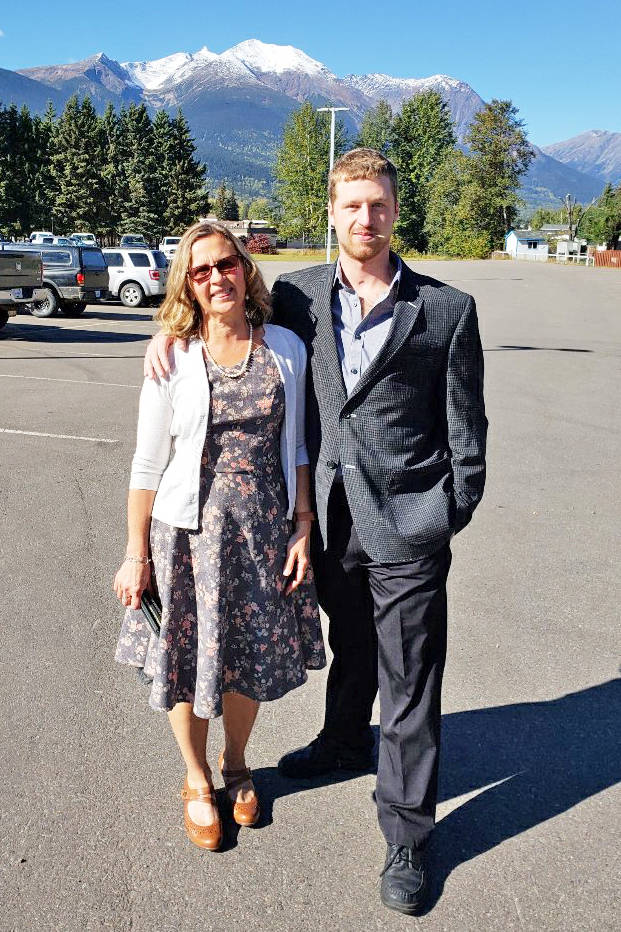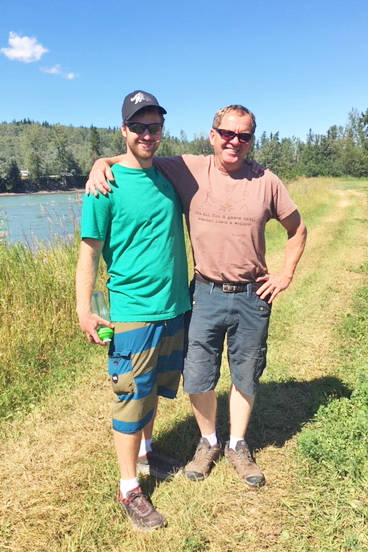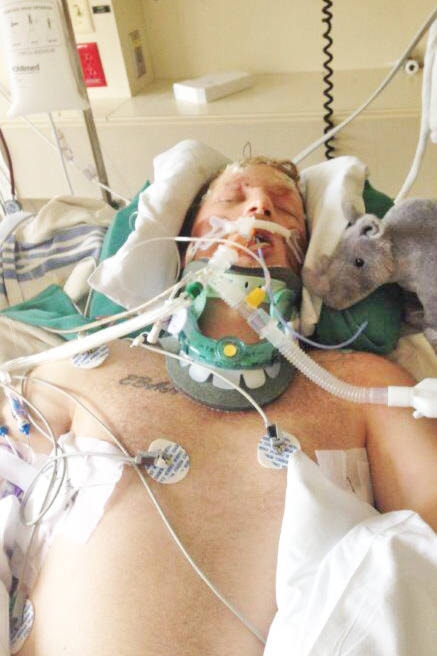Ryan Jones does not remember skidding in the snow on May 20, 2016 in Fort St. John causing his chest to slam into the steering wheel and sending him into cardiac arrest.
“My first memory was waking up in GF Strong [Rehabilitation Centre] in Vancouver five-and-a-half months later,” Ryan told Black Press Media.
Now, the 25-year-old Smithers man is at the forefront of a new medical intervention that could save countless lives.
Dr. Mypinder Sekhon, who was a member of the team that treated Ryan at Vancouver General Hospital when he first arrived via air ambulance in the Lower Mainland, said the prognosis was bleak from the start.
“In Ryan’s case, every textbook and every prognostication would have told you we should stop the life support, that he was going to have a dismal outcome,” Sekhon said during an interview by telephone.
A life and death decision
At the time of Ryan’s accident, Vancouver General had been using a technique called autoregulation monitoring (ARM) for approximately eight months to customize treatments for victims of traumatic head injuries. The procedure involves placing catheters in a patient’s brain using an apparatus called a Brain Bolt, which provides critical information that gives the medical team an opportunity to limit or even reverse brain damage, Sekhon explained.
It had never been tried, anywhere, in a cardiac arrest case.
“Ryan sustained a pretty long cardiac arrest,” Sekhon said. “His heart had stopped for quite some time and even after it had been restarted his body wasn’t getting enough oxygen and his brain wasn’t getting enough blood flow. We’ve been using this technology of the Brain Bolt in brain injuries that result from trauma, so when Ryan came to Vancouver General, the CT scan suggested what we feared, that the brain had been damaged and we had never undertaken this type of procedure or monitoring in a cardiac arrest patient.”
It was Sekhon’s colleague, Dr. Don Griesdale, who came up with the idea.
“Admittedly, it hadn’t crossed my mind before, so we didn’t really have much to lose at that point given how severe Ryan was,” Sekhon said.
But ethically, it was not a decision for the doctors to make, so they took it to Ryan’s parents, Donna and Jim Jones.
“We were upfront with them, we were not sure it was going to work in his case,” Sekhon said.
Fortunately for Ryan, his parents were of the same mind as the medical team.
“Our thought at the time was, we don’t know if this is going to help Ryan, but if it can be part of research that helps other people in the future then absolutely go ahead,” Donna recalled. “That’s what we said to the doctors.”
A life-saving intervention
While the hospital had had some success with head trauma patients, they were treading on new ground with Ryan.
“We didn’t know what we were going to find when we put the catheters in his brain,” Sekhon said. “What we found was the oxygen levels were very low, but more than that we established that once we actually augmented his heart function, augmented the lung function, that we were able to increase and normalize the oxygen levels in his brain.
“When he had a great outcome, we started thinking, ‘well, can we start to use this in other cardiac arrest patients and can we study it?”
They did, and the resulting paper has now been published in the May 2019 edition of Critical Care Medicine—the official journal of the Illinois-based Society of Critical Care Medicine.
“We’ve done it in about 15 people now in the last year and a bit,” Sekhon said. “Eight of them have survived to full recovery. Seven have still died, so a bit better than 50 per cent.
Sekhon acknowledges it is a far cry from a definitive study, but views the results as very promising.
“These numbers are really, really small, so it’s hard to draw any really meaningful conclusions about it, but traditionally the good outcome rate, good being full recovery, is in the single digits, or the high teens,” he explained.
The research shows some potentially ground-breaking results.
“The old dogma has been that in cardiac arrest the [brain] injury that you get is dependent upon the initial time at which the heart is stopped and then after restarting the heart, it’s not modifiable,” Sekhon noted.
“Secondly, traditional thinking has been we’re not able to heal the brain by getting adequate oxygen delivery to the brain and so forth.
“What we found was, by changing various interventions, we are able to increase oxygen levels in the brain after resuscitating somebody, after restarting the heart, so that tells us that the brain is, in fact, not dead and the injury is likely modifiable.
“Secondly the study demonstrated that currently how international guidelines recommend that we treat people is with a cookie cutter approach. Everybody gets the same management.
“What we’ve found is there’s tremendous differences within patients, in how their management differs, or how the brain injury is different, so instead of a one-size-fits all approach, we ought to move towards individualizing the care, or personalizing the medicine.”
The paper’s authors will soon be taking their findings on the road to disseminate the information to other hospitals around British Columbia, Sekhon said.
A long road to recovery
It has been almost three years since that fateful day, and Ryan Jones has been in rehabilitation pretty much ever since.
From November 2017 to February of this year, he was in treatment at the Watson Centre for Brain Health in Burnaby. Donna said the program there “helped a ton.”
“The brain is so amazing how it can retrain itself,” she said.
“He’s pretty good, I wouldn’t say he’s 100 per cent back to how he was before the accident, but he’s getting very close and he’s making improvements still, they’re just not as noticeable as they were when he first started into the recovery phase of it.
“He has a tough time with a lot of stuff, but no more than anyone else that has a tough time dealing with stuff, he just has a bit of a disadvantage over someone who’s never had a brain injury, because brain injuries are funny things and everybody reacts differently with the symptoms.”
Physically, Ryan is back to his normal self, he said, playing sports and doing pretty much all the things he did before the accident.
C
Mentally, he is a work in progress.
“I’ll always have issues, I’m sure,” he said. “The problems for me are definitely memory in general, short- and long-term memory.
“My really, really long-term memory is done for. The only time I have my long-term memory recalls is when I’m going to Facebook and looking up old photos and stuff like that. Other times when I have memory recalls is when someone will mention a story and, not a hundred per cent clearly, but I will somewhat recognize what they’re generally talking about so it’s not a full memory, but I’ve got the idea of it.”
An undying gratitude
Ultimately, Ryan and his family feel very lucky he got to be the first person to benefit from what amounted to an experimental intervention at the time.
“I mentioned to my mom, a week or two before May 20, 2017, I have two birthdays every year now,” he said. “In my point of view, and everyone else’s point of view, I actually did die on that day of my accident.”
He said recognizing the second birthday is more of an observance than a celebration, however.
“I’m not sure you can call it celebrating,” he said. “It is a pretty big deal in my life, but it would be a bit weird to celebrate the day of the accident.”
Donna said it is hard to explain how grateful they are.
“At first they told us he was not going to survive,” she said. “Then it was, OK, if he does survive he’ll have to live in an institution and be bedridden the rest of his life. We were always being prepared that we were going to have to make a choice whether we were going to continue treating him or not, but we just never gave up and the outcome has been incredibly wonderful.”
Their gratitude is not just for the medical professionals, who saved his life and oversaw his recovery and rehabilitation, though.
“The family really thanks the community [of Smithers] for all the support,” Donna said.
“We had a ton of support from family and friends and co-workers, so we would just like to say thank you to the community for all the support.”





